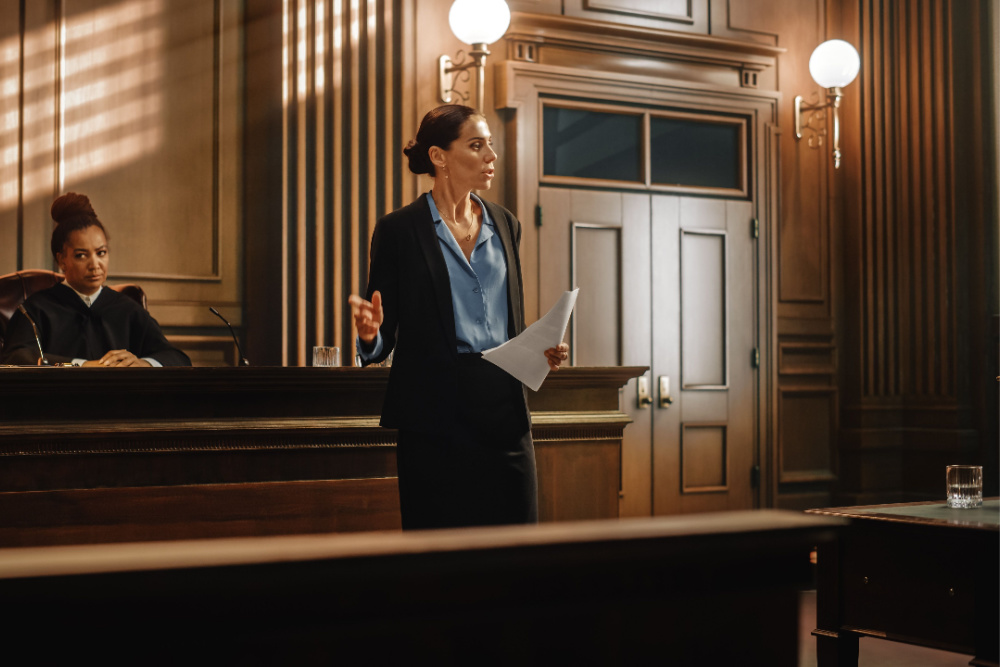
The closing argument is pivotal in any trial, offering the final opportunity to convince the jury or judge of your client’s position. Crafting a compelling closing argument requires a deep understanding of the law and the facts of the case and an ability to connect with the audience on a human level. It’s about synthesizing the entire case into a coherent, persuasive narrative highlighting your strengths and mitigating your weaknesses.
A powerful closing argument does more than recap the evidence; it ties all the pieces of the trial together, addresses the burden of proof, and appeals to the emotions and logic of the jurors. It’s your last chance to speak directly to the jury before they deliberate, making it crucial to leave a lasting impression that sways their decision in your favor.
Building a Narrative Foundation
Crafting a Story That Resonates
Every compelling closing argument is grounded in a strong narrative. Humans are naturally drawn to stories, and jurors are no exception. Begin by establishing a storyline that weaves through your evidence and testimony, one that is simple, relatable, and supported by the facts of the case. Your narrative should give jurors a framework for understanding the case, allowing them to see the events from your perspective.
In constructing this narrative, focus on the themes that have emerged during the trial and use them to frame your argument. Whether it’s the idea of fairness, responsibility, or trust, anchoring your closing in a theme that resonates with the jury’s values can make your argument more compelling. Personalizing the story is essential, as well as making sure the jurors see your client as a real person, not just a name in a lawsuit.
Highlighting Key Evidence
While your narrative provides the structure of your closing argument, the evidence is its foundation. Select the most impactful pieces of evidence presented during the trial and integrate them into your narrative, emphasizing how they support your case. Be strategic in your selection, focusing on evidence that is most likely to influence the jury’s decision.
It’s also essential to address any weaknesses or inconsistencies in your case. Acknowledge them upfront and frame them within the context of your overall narrative. This enhances your credibility and allows you to control the narrative, preventing the opposition from capitalizing on these points during their closing argument.
Engaging the Jury
Utilizing Persuasive Language and Tone
Your language and tone in your closing argument can significantly impact its effectiveness. Opt for clear, concise language that conveys your message without overwhelming the jury with legal jargon. Your tone should be confident but not arrogant, passionate but not melodramatic. It’s a delicate balance to strike, but it can powerfully enhance your message when done correctly.
Use rhetorical devices such as repetition, analogies, and rhetorical questions to reinforce key points and make them more memorable. These techniques emphasize the strength of your case and encourage jurors to view the evidence in the light most favorable to your client.
Engaging Emotionally and Logically
A genuinely compelling closing argument engages the jurors’ hearts and minds. Appeal to their emotions by highlighting the human aspects of your case, using storytelling to evoke empathy and understanding. However, emotional appeal alone is insufficient; you must also address the logical aspects, guiding jurors through the reasoning supporting your conclusion.
Balancing emotional appeal with logical reasoning ensures that your argument resonates with jurors personally while satisfying their intellectual evaluation of the case. This dual approach maximizes the persuasive impact of your closing argument, appealing to the diverse perspectives within the jury.
Concluding with Impact
Reinforcing Your Key Messages
As you conclude your closing argument, reinforce the key messages you want the jurors to remember. This is your final opportunity to summarize the most compelling aspects of your case and remind the jury of the narrative you’ve constructed. Be concise and focused, leaving the jurors with a clear understanding of why the evidence supports your position.
A strong conclusion summarizes the case and calls the jurors to action, urging them to deliver a verdict in your favor. It should leave no doubt in their minds about the rightness of your cause and the justice of your client’s position.
Leaving a Lasting Impression
The final words of your closing argument should be carefully chosen to leave a lasting impression on the jurors. Use powerful, emotive language that encapsulates the essence of your case and reinforces the emotional connection with the jury. The goal is to ensure that, as they deliberate, the jurors remember the facts of the case and the feelings it evoked.
Conclusion: The Artistry of Closing Arguments
Mastering the closing argument is an art that requires practice, precision, and a deep understanding of human psychology. By crafting a compelling narrative, highlighting key evidence, engaging the jury emotionally and logically, and concluding with impact, you can significantly increase your client’s chances of a favorable outcome.
Are you looking for a certified court reporter in Trenton, New Jersey? If so, contact us today.
